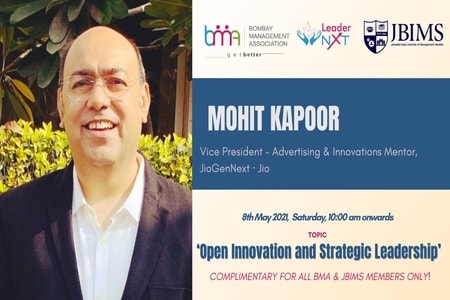
- This event has passed.
Special Celebrity Leaders Speak Session By: Mr. Mohit Kapoor on Open Innovation and Strategic Leadership
May 8, 2021 @ 10:00 AM UTC+5.5

All BMA & JBIMS Members are Cordially Invited to a Special Celebrity Leaders Speak Session By: Mr. Mohit Kapoor
About Speaker:
Vice President – Advertising & Innovations I Mentor, JioGenNext · Jio
• First Principles Thinker and Senior P&L leader in the corporate think tank of Reliance Jio, World’s largest Data Carrier and India’s largest TelCo (subscribers and revenue) with 400+ million subscribers
• Founder of two Start-ups Goolel and Apps Kiosk (a) one provided all the Wisdom and Humility and (b) second was Exited in Reliance Jio – a university of scale, disruptive innovation, and infinitive growth
• Digitisation Specialist, Consumer Marketer, Growth Hacker
• Venture Catalyst
Brief on the Topic: Open Innovation and Strategic Leadership
Open innovation has become well established as a new imperative for successful organisations that thrive on innovation. The term Open Innovation was first developed by Henry Chesbrough in 2003 in Open Innovation: The New Imperative for Creating and Profiting from Technology (HBS Press).
It is a business management model for innovation that promotes collaboration with people and organizations outside the company. In this sense, open innovation challenges are a true cultural break from the company silo mentality and the secrecy traditionally associated with the corporate R&D culture. This innovation model becomes viable when the company acknowledges that there are many bright professionals and greater knowledge outside the organization. It is in this very moment when the opportunity to attract those external individuals and/or companies becomes more real. Companies implement open innovation practices in different ways such as alliances between companies, research chairs in universities, crowdsourcing competitions, and innovation ecosystems.
Chesbrough has identifies five key elements in the new innovation process, i.e.:
1. Networking
2. Collaboration involving partners, competitors, universities, and users
3. Corporate Entrepreneurship, especially through corporate venturing, start-ups and spin-offs
4. Proactive Intellectual Property Management: to buy and sell intellectual property and so create markets for technology
5. Research and Development (R&D): to obtain competitive advantage on the marketplace
Our speaker, Mr Mohit Kapoor will elucidate on the imperatives and successful implementation in today’s context.
Limited Seats Available.